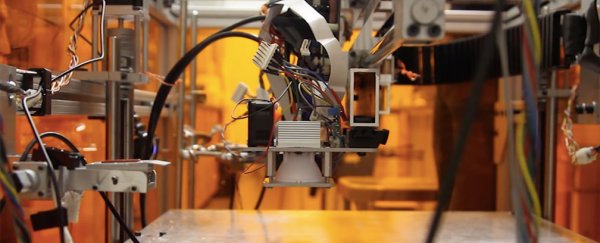As scientists figure out how to use awesome new materials in 3D printers, one big problem remains: the vast majority of 3D printers only work with one kind of source material (for example, plastic) which severely limits the complexity of the objects you can make.
But now, for the first time, scientists in the US have developed a 3D printer that can print with a record-breaking 10 materials at a time, which will allow a whole new range of objects to be printed quickly and easily without requiring any manual post-print assembly of individually printed components.
While some existing industrial 3D printers can also print with multiple materials, they aren't exactly cheap (costing upwards of US$250,000. And even then, they've been limited to a maximum of three materials at once.
The MultiFab printer on the other hand, developed by researchers at the Computer Science and Artificial Intelligence Lab (CSAIL) at the Massachusetts Institute of Technology (MIT), only cost its makers US$7,000 to build from scratch and features innovations that make 3D printing of complex objects easier than ever.
In addition to its ability to print with up to 10 source materials at once, the MultiFab uses machine vision 3D-scanning techniques that allow the printer to self-calibrate and guide itself as it prints.
"The platform opens up new possibilities for manufacturing, giving researchers and hobbyists alike the power to create objects that have previously been difficult or even impossible to print," said Javier Ramos, one of the CSAIL research engineers who worked on the project, in a press release.
Unlike material extrusion methods of 3D printing, which the researchers liken to using a syringe to apply cake frosting, the MultiFab printer mixes microscopic droplets of photopolymers together and prints with much finer printheads.
Together with the machine vision, this enables the printer to 3D-scan an object and then print directly around it with extreme precision. The researchers say you could place an iPhone inside the printer and tell it to print a case directly onto the phone. Or you could start off with circuits and sensors and print around them, effectively embedding a functional electronic device at the heart of a new 3D-printed object.
"Right now a big portion of 3D printing, the hardware that's available, is focused on printing form and objects for prototype," says Ramos in the video below. "The holy grail is to print things that are fully functional right out of the printer, combining multiple materials with many different properties, but also existing objects that have some inherent functionality."
The team's paper, presented this month at the 42nd International Conference and Exhibition on Computer Graphics and Interactive Techniques in the US, could have major implications for the way people make objects, with potential applications for researchers, personalised consumer items, or even mass-manufactured products.
"Picture someone who sells electric wine-openers, but doesn't have $7,000 to buy a printer like this. In the future they could walk into a FedEx with a design and print out batches of their finished product at a reasonable price," said Ramos. "For me, a practical use like that would be the ultimate dream."

